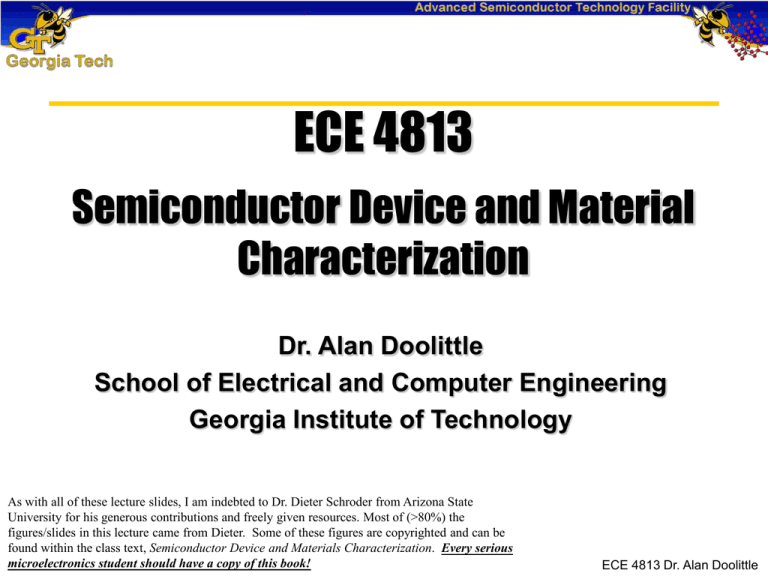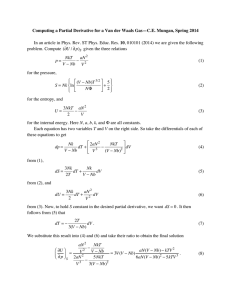Lecture 5 - ECE Users Pages
advertisement

ECE 4813 Semiconductor Device and Material Characterization Dr. Alan Doolittle School of Electrical and Computer Engineering Georgia Institute of Technology As with all of these lecture slides, I am indebted to Dr. Dieter Schroder from Arizona State University for his generous contributions and freely given resources. Most of (>80%) the figures/slides in this lecture came from Dieter. Some of these figures are copyrighted and can be found within the class text, Semiconductor Device and Materials Characterization. Every serious microelectronics student should have a copy of this book! ECE 4813 Dr. Alan Doolittle Diodes PN Junction Diodes Current - Voltage Series Resistance Schottky Diodes ECE 4813 Dr. Alan Doolittle PN Junction Diodes The current in a Si pn junction diode at room temperature is due to recombination in the space-charge region, Iscr, and the quasi-neutral regions, Iqnr q (V − Irs ) q (V − Irs ) − 1 + − 1 Io ,qnr exp I = Io ,scr exp nscr kT nqnr kT Current (A) 100 For V > 3kT/q and negligible rs: 10-2 ∆V = Irs 10-4 qV I = Io exp nkT qnr 10-6 log I = log Io + qV nkT ln 10 Slope = 1/2.3nkT/q V = 0 intercept ⇒ I = Io 10-8 scr Io,scr Io,qnr 10-10 10-12 0 0.2 0.4 Slope = 0.6 0.8 1 1 d log I = ln 10 nkT q dV Voltage (V) ECE 4813 Dr. Alan Doolittle PN Junction Diode Resistance Diode series resistance reduces the current qVd I = I0 exp − 1 nkT V = Vd + Irs q (V − Irs ) I = I0 exp − 1 nkT I + rs 100 + Vd V _ _ Current (A) 10-2 ∆V = Irs 10-4 qnr 10-6 10-8 scr 10-10 10-12 0 0.2 0.4 0.6 0.8 1 Voltage (V) ECE 4813 Dr. Alan Doolittle Diode Resistance Diode conductance gd = I (1 − rs gd ) nkT q 0.2 0 0 Slope = rs Intercept = nkT/q 0.2 0.4 0.6 0.8 Current (A) gd 1 − rs gd = I nkT q I nkT = + Irs gd q 0.3 0.1 40 gd/I (V-1) I/gd (V) q (V − Irs ) I = Io exp nkT 0.4 Intercept = q/nkT 30 Slope = qrs/nkT 20 10 Intercept = 1/rs 0 0 0.5 1 1.5 2 2.5 gd (S) ECE 4813 Dr. Alan Doolittle Schottky Barrier Diodes Schottky barrier diodes have I-V curves very similar to pn junction diodes The turn-on voltage can be controlled more than that of pn diodes because the barrier height can be controlled somewhat I = I s (e qV nkT − 1); I s = AA*T 2e −qφ kT B A* = 4πqk 2 mn* h 3 = 120(m0 mn* ) A / cm 2K 2 Richardson Constant φB Ec Ec EF Ev φB EF Ev ECE 4813 Dr. Alan Doolittle Schottky Barrier Diodes: I - V I = I s (e qV nkT − 1); I s = AA*T 2e −qφ B kT Want n, A* and φB Current - Voltage log I = log IS + qV nkT ln 10 V = 0 intercept ⇒ I = IS 1 d log I = Slope = ln 10 nkT q dV 10-5 Current (A) 10-7 Slope = 1/2.3nkT/q 10-9 Intercept = IS kT AA*T 2 φB = ln q IS 10-11 0 0.1 0.2 0.3 0.4 Diode Voltage (V) Need to know A* For V ≥ 4 kT q ⇒ I = I se qV nkT ECE 4813 Dr. Alan Doolittle Schottky Barrier Diodes: I - T log(J/T2) versus 1/T To determine φB and A* J = A*T 2 exp(− q (φB − V n ) kT ) q (φB − V n ) ln (J T ) = ln A − kT 2 * 1/T = 0 intercept = A* 10-6 J/T2 (A/cm2K2) d log ( J T 2 ) q (φB − V n ) Slope = =− ⇒ φB d(1 T ) k ln( 10 ) Intercept = A* 10-7 Slope= -q(φB-V/n)/2.3k 10-8 V = 0.3 V 10-9 2.5 10-3 2.9 10-3 3.3 10-3 1/T (K-1) ECE 4813 Dr. Alan Doolittle Schottky Barrier Diodes: I - V Barrier height can be determined from I-V or I-T plots Forward-biased current is very sensitive to barrier height If barrier height non-uniform, the lowest barrier height regions dominate Series resistance is important 101 10-1 0.6 V 10-3 A/2, φB=0.6 V A/2, φB=0.7 V 10-5 10-7 φB=0.7 V rs=0 0 0.1 0.2 0.3 0.4 0.5 0.6 Diode Voltage (V) Current (A) Current (A) 101 10-1 0.6 V, rs=10 Ω 10-3 A/2, φB=0.6 V A/2, φB=0.7 V 10-5 10-7 φB=0.7 V, rs=0.1 Ω 0 0.1 0.2 0.3 0.4 0.5 0.6 Diode Voltage (V) ECE 4813 Dr. Alan Doolittle Schottky Barrier Diodes: C - V C-V measurements are less sensitive to φB variations C qK sε 0ND = A 2(Vbi − V ) φB 2(Vbi − V ) A = qK sε 0ND C Vbi 2 Ei Slope ⇒ ND Slope = EF φF −2 qK sε 0ND Intercept ⇒ φB φB = Vbi + Vo Vo = EG q − E i / q − φF 1.5 1014 (A/C)2 (cm4/F2) Ec Vo 1 1014 Slope 5 1013 Intercept 0 -1 0 1 2 3 4 Diode Voltage (V) ECE 4813 Dr. Alan Doolittle Review Questions Why is the I-V curve a straight line on a semilog plot? Why does a Si diode logI – V curve have two slopes? How does series resistance affect the diode current? How is the barrier height of Schottky diodes determined? Why can the Schottky diode barrier heights be different when determined from I-V or C-V data? ECE 4813 Dr. Alan Doolittle
